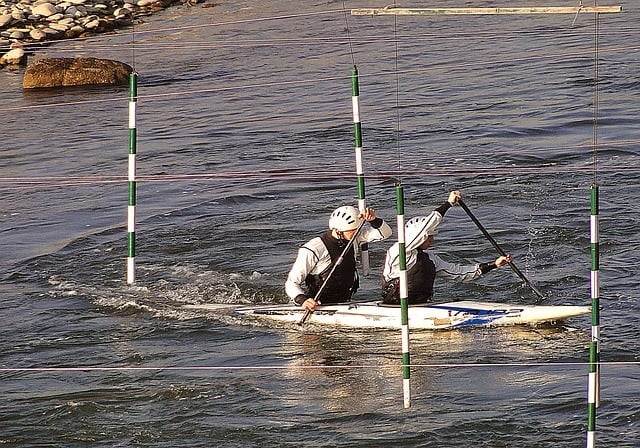When approaching a low-head dam in a kayak or canoe, you should take proper precautions because Low-head dams create a strong recirculating current that can trap and drown swimmers and boaters. What you can do is, portage around it by carrying your kayak or canoe around the dam. Based on the situation, here’s what many are compelled to do:
- Jump off the kayak and walk around the dam
- Paddle ashore
- Shun altogether

What Is A Low-Head Dam?
A low-head dam is a perfectly uniform drop in the river. This is a man-made structure that usually covers the entire width of a river. Low-head dams are created to raise water levels. They are intended to improve water supplies. Water irrigation also gets a boost from these dams as well.
However, there aren’t downsides. The downside here for kayakers and canoeists is that they can be dangerous. Even swimmers will find themselves in real peril sometimes with the dams.
The danger is coupled with visual challenges. Often you will find it difficult to spot them when on a kayak or swimming. It’s because the low-head dams appear flat from the surface as you approach. Moreover, the refraction of light makes it even more difficult to measure their depth.
Depending on conditions, the actual low head dams can be found a few feet under the surface of the water. They can often be quiet. So, it is hard to spot them from the water level upstream. Although the low-head dams are man-made, there are natural ones as well.
The dams can hold boats. In many cases, swimmers get stuck in there as well. Evidently, the dams are not safe to play in – quite hazardous. Even at low speeds, the waters flowing over a low-head dam can create a dangerous situation, in which boaters and swimmers are likely to get carried over the edge.
In May 2017, two women kayaking tried to go over the dam and got caught in the recalculating water beneath it. The body of one woman was immediately recovered, while the body of the other woman was found the day next.
So, it doesn’t require a clearer example of how dangerous the low-head dam can be.
Still, If You Need Even Much Clearer Reasons Why You Should Avoid A Low Head Dam, Then The Dangers Are As Follows:
1. Looking at the small drop and smooth water flowing doesn’t give off the slightest indication of how dangerous the force of the water underneath can be. The force of the water is enough to pull you right down.
2. You may be the strongest kayaker or swimmer, but no way can you withstand such Himalayan force!
3. The debris, such as branches will seem so overpowering no matter how strong you are. You will be constantly sucked down and shot up.
4. As water flows over the dams, the flow creates a hydraulic. It is strong enough to pull any object near the surface back toward the dam. So, it is an educated guess that your kayak will be pulled back into the dam, keeping you trapped against the dam.
5. The incoming water over the dam will pull you and your kayak under the water, thereby making it difficult for you to escape.
Low-Head Dam In Sight: What Should I Do?
So, when kayaking happily on the water, the last thing you want to encounter is a low-head dam. Even if you find yourself against one, don’t panic at all!
Here’s what you can do:
Paddle your way over to the nearest bank as soon as you noticed the signs of an upcoming dam. Since the low-head dams are hard to spot, there should be signs warning against going past them. Once you have moved to the nearest bank, you can walk around them.
Precautionary Measures:
1. Plan your route before setting off. You don’t know the river well no matter how many years you have spent around it.
2. Gather as much information as you can on the river. And, pay very close attention to dams existent.
3. If you are not a local, then collect detailed maps and guides. Even there is a seasoned map when most Dams are found on USA rivers. Check it out here.
4. Do not always look for signs, they may not be available in every spot.
Bottom Line
Low-head dams will surely test you if you encounter them. When you are kayaking on a river, make sure you are aware of any low-head dam you may have to go through. Even if you approach one, learn what you can do in such a situation. This is absolutely crucial to know for any kayaker.
References:
- https://www.quora.com/What-should-you-do-when-approaching-a-low-head-dam-in-a-canoe-or-kayak
- https://www.baysports.com.au/blogs/blog/what-should-you-do-when-approaching-a-low-head-dam-in-a-canoe-or-kayak

Rockey is a kayaking enthusiast who has been kayaking with a local group for the last five years. He loves using kayaks while out on outings on the water or camping when the friends want to have a BBQ party somewhere on the bank of a local lake. More About James R Rockey at About Page Here: Authors
Based on his experiences with the different types of kayaks, he is sharing his opinion about kayaking tricks and required gears so that a beginner can get started right away.
Find his team on Twitter here. Happy reading!
